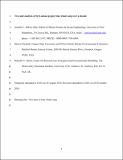Files in this item
Two unit analysis of Sri Lankan pygmy blue whale song over a decade
Item metadata
| dc.contributor.author | Miksis-Olds, Jennifer L. | |
| dc.contributor.author | Nieukirk, Sharon L. | |
| dc.contributor.author | Harris, Danielle V. | |
| dc.date.accessioned | 2019-05-12T23:38:17Z | |
| dc.date.available | 2019-05-12T23:38:17Z | |
| dc.date.issued | 2018-12-31 | |
| dc.identifier | 257367806 | |
| dc.identifier | f55fa730-c50f-4bde-aa26-2cd5725e9493 | |
| dc.identifier | 85059395320 | |
| dc.identifier | 000454625000056 | |
| dc.identifier.citation | Miksis-Olds , J L , Nieukirk , S L & Harris , D V 2018 , ' Two unit analysis of Sri Lankan pygmy blue whale song over a decade ' , Journal of the Acoustical Society of America , vol. 144 , no. 6 , pp. 3618-3626 . https://doi.org/10.1121/1.5084269 | en |
| dc.identifier.issn | 0001-4966 | |
| dc.identifier.other | RIS: urn:7C82A0C7D30752F78AEAEE2FEABC93ED | |
| dc.identifier.other | ORCID: /0000-0003-1447-1420/work/61370034 | |
| dc.identifier.uri | https://hdl.handle.net/10023/17689 | |
| dc.description | J.L.M.O. and S.L.N. were funded by the Office of Naval Research (Award No. N000141110619). D.V.H. was funded by the Office of Naval Research (Award No. N000141612364). | en |
| dc.description.abstract | Sri Lankan pygmy blue whale song consists of three repeated units: (1) low frequency pulsive unit, (2) frequency modulated (FM) upsweep, and (3) long tonal downsweep. The Unit 2 FM unit has up to three visible upsweeps with energy concentrated at approximately 40, 50, and 60 Hz, while the Unit 3 (∼100 Hz) tonal downsweep is the most distinct unit lasting 20–30 s. Spectral characteristics of the Units 2 and 3 song elements, along with ocean sound levels, were analyzed in the Indian Ocean from 2002 to 2013. The peak frequency of the tonal Unit 3 calls decreased from approximately 106.5 to 100.7 Hz over a decade corresponding to a 5.4% decrease. Over the same time period, the frequency content of the Unit 2 upsweeps did not change as dramatically with only a 3.1% change. Ambient sound levels in the vocalization bands did not exhibit equivalent patterns in amplitude trends. Analysis showed no increase in the ambient sound or compensated peak amplitude levels of the tonal downsweeps, eliminating the presence of a Lombard effect. Here it is proposed that each song unit may convey different information and thus may be responding to different selective pressures. | |
| dc.format.extent | 9 | |
| dc.format.extent | 1164923 | |
| dc.language.iso | eng | |
| dc.relation.ispartof | Journal of the Acoustical Society of America | en |
| dc.subject | Sri Lankan pygmy blue whale | en |
| dc.subject | Song | en |
| dc.subject | Ambient sound | en |
| dc.subject | Selection | en |
| dc.subject | QH301 Biology | en |
| dc.subject | 3rd-DAS | en |
| dc.subject.lcc | QH301 | en |
| dc.title | Two unit analysis of Sri Lankan pygmy blue whale song over a decade | en |
| dc.type | Journal article | en |
| dc.contributor.institution | University of St Andrews.School of Mathematics and Statistics | en |
| dc.contributor.institution | University of St Andrews.Sea Mammal Research Unit | en |
| dc.contributor.institution | University of St Andrews.Centre for Research into Ecological & Environmental Modelling | en |
| dc.identifier.doi | 10.1121/1.5084269 | |
| dc.description.status | Peer reviewed | en |
| dc.date.embargoedUntil | 2019-05-13 |
This item appears in the following Collection(s)
Items in the St Andrews Research Repository are protected by copyright, with all rights reserved, unless otherwise indicated.

